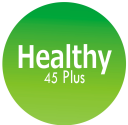Cataracts are cloudy or foggy areas that form over the lens of the eyes. These are some of the common health problems with increasing age. It commonly occurs in people above 40 years, hence for a healthy 45 plus period, you need to be aware of cataract.
Cataracts can occur in children right from birth, they are called congenital cataracts. Also, some people may be at greater risk of cataracts due to eye injuries, surgeries of other conditions of the eye like glaucoma. However, we will look at age-related cataracts, which occur in aging people, as a part of degenerative changes.
Age-Related Cataract
Age-related cataract is an important health condition that people above 45 years must consider. Knowing the risk factors and symptoms of age-related cataracts can help in every way.
As it may not be easily noticed initially, you need to be more cautious. It begins with a slight blurring of vision, haziness, or less colorful vision. Eventually, this can progress and reach a point when vision is severely hampered and it can even affect your day-to-day activities. However, if you are aware, you can take the right steps. Timely diagnosis and treatment can help you get rid of cataracts completely. Surgery is the best-considered treatment option for cataract and when done in time, it helps to restore your vision.
Let us understand some of the important aspects of age-related cataracts.
How does age-related cataract occur?
Most cataracts are a part of the normal aging process and occur due to degenerative changes in the eyes. Usually, in young people, the lens is clear and so is the vision. As age advances, the body begins to show changes in various organs and body functions. After 40 years of age, the proteins in the lens of the eye begin to break down and start getting clumped together. This starts getting formed over the lens, making it cloudy or foggy. As this process begins, you can experience some blurring of vision or haziness. This process continues as any other wear and tear process and gradually, you may begin experiencing more blurring of vision. If these conditions are not detected in time and treated appropriately, it can also lead to a complete loss of vision.
Some factors may hasten this process while some preventive action may help to prolong the changes. Knowing the risk factors and symptoms can help you seek timely medical advice and plan preventive steps that can help you protect your eyes.
What are the Risk Factors of Age-Related Cataracts?
The most vital risk factor for age-related cataracts is your increasing age. People above 40-45 years are at more risk and the risk continues to increase as the age advances. It is believed that most people by they reach 80 years of age, either have cataracts or have undergone cataract surgery.
In addition to this, there are certain risk factors, which can play an important role. The presence of these factors can increase your risk of having cataracts or may even make it appear earlier.
Such risk factors of age-related cataracts include
• Having diabetes – Persistent high blood sugar levels can affect the lens, making it cloudy and hastens the formation of cataract.
• Having a family history of cataracts or eye-related problems
• Having an eye injury or other eye problems
• Having undergone eye surgery or radiation or similar treatment for the head, face, or neck.
• Being treated with certain medications like steroids, used for various health conditions.
• Habits like smoking and drinking
What are the Symptoms of Age-Related Cataracts?
Initially, you may not notice any symptoms of cataracts. But as the condition progresses, you may observe certain changes in your vision. Some of the symptoms of age-related cataracts include
• Cloudy or blurry vision, some people also experience double vision
• Inability to see clearly at night
• Colors may appear as if it is faded
• The appearance of a halo around lights
• Lights may appear too bright or there may be over-sensitivity to sunlight
• Prescription glasses may seem a problem and may show frequent alterations
Once the diagnosis of cataract is confirmed, your doctor may advise you on the need and urgency of the surgery to treat this condition.
How to Protect your Eyes?
While cataracts can be prevented or not depends on various factors and individual health condition. However, the best approach is to take precautions and necessary preventive steps to protect your eyes.
• Wear Sunglasses – Ultraviolet rays harm the eyes. In some people, it can worsen the eye changes rapidly. Hence, it is advised to protect your eyes from the sun by wearing sunglasses and if possible, a hat with a brim.
• Eat Healthy – Certain fruits and vegetables are rich in vitamins and minerals important for the eyes. Include carrots, greens, dark leafy veggies, and fruits like oranges, papaya, mangoes, in your diet. A diet rich in omega-3-fatty acids helps in maintaining good health. Include walnuts, almonds, flaxseeds, fatty fish like salmon, tuna, mackerel.
• Quit Smoking /Limit Alcohol – As these habits are known to increase your risk, they are best avoided.
• Manage Medical Conditions – One of the most important ways to protect your eyes is to control medical conditions that can result in complications of the eyes. Take necessary action to prevent or manage prediabetes, diabetes, high blood pressure, and eye-related problems.
• Prevent Eye Injuries – Wear appropriate protective eye gear during adventure and contact sports, while performing some occupational tasks.
• Go for Regular Eye Examination – Regular eye check-up from an ophthalmologist can help in detecting any eye problems in time. With medical advice, you can take appropriate measures to manage medical conditions that increase your risk and learn ways to take care of your eyes.
June is observed as Cataract Awareness Month – a crucial health condition for 45 plus. So, let us take the right steps and protect our eyes.
- All You Need To Know About Brain Stroke - October 1, 2020
- The Aging Knee – What Can You Do? - August 27, 2020
- What Is Osteoarthritis? How To Prevent or Manage It? - August 24, 2020


 Please wait...
Please wait...